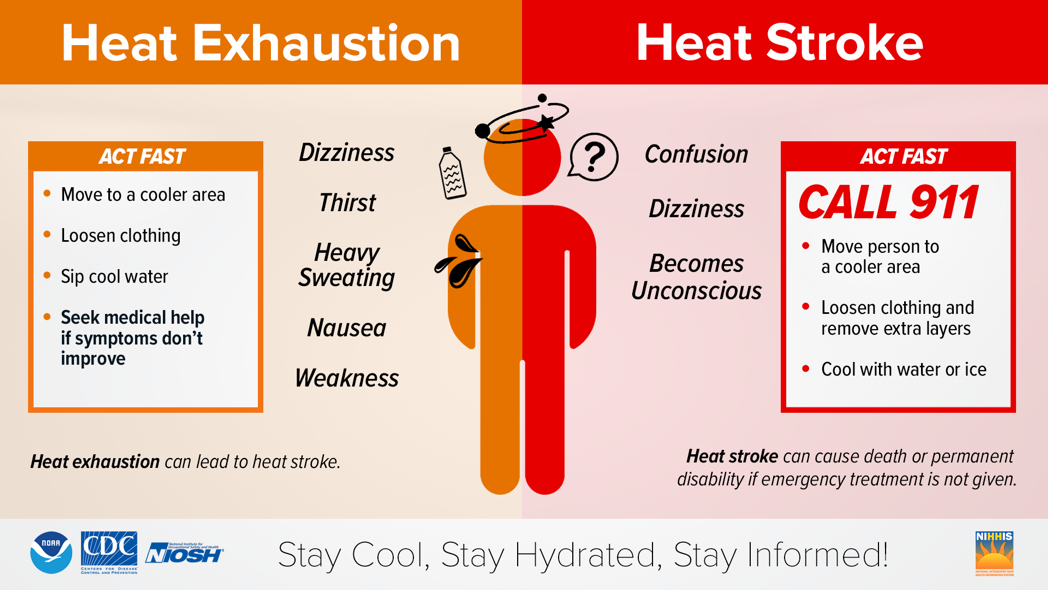Acclimatization to heat involves a series of changes that occur in an individual during the first week of exposure to hot environment conditions. Full acclimatization can take up to a week. For employees working outdoors or in h to indoor environments, the heat can lead to serious illness.
Dehydration is one of the first indicators of heat-related issues. Dehydration occurs when the body loses too much water without being replaced. This lack of adequate hydration then prevents the body from performing its normal functions. Even mild dehydration can produce symptoms that range from mood shifts and headaches to muscle cramps and constipation. to prevent dehydration, drink plenty of fluids and eat foods high in water such as fruits and vegetables. During the activity, replenish fluids after you’re finished. Signs of mild or moderate dehydration include:
- Thirst
- Dry or sticky mouth
- Not urinating very much
- Dark yellow urine
- Dry, cool skin
- Headache
- Muscle cramps
When it’s hot and humid, your risk of dehydration and heat illness increases. That’s because when the air is humid, sweat can’t evaporate and cool you as quickly as it normally does, and this can lead to an increased body temperature and the need for more fluids. If the body cannot dispose of excess heat, it will store it.l When that happens, the body’s core temperature rises, and the heart rate increases. As the body continues to store heat, the individual begins to lose concentration and has difficulty focusing on a task, may become irritable or sick, and often loses the desire to drink. The next stage is most often fainting and death is possible, if the person is not treated. The most common heat disorders are as follows:
HEAT RASH – Excessive sweating during hot and humid conditions causing red, blotch skin rashes: clusters of pimples or small blisters. Treatment: Keep the affected area as dry as possible, and treat it with cornstarch or powder.
HEAT CRAMPS – Painful spasms of the muscles are caused when minerals are sweated out of the body and not replaced. The muscles used to perform the work are usually the muscles most susceptible to cramping. Treatment: Take liquids by mouth, water, or sports drinks such as Gatorade. Bananas help replace lost minerals. Intravenous saline solutions, if deemed necessary by medical personnel.
HEAT EXHAUSTION – Characterized by headaches, dizziness or lightheadedness, weakness, mood changes or irritability, confusion or the inability to think straight, upset stomach, vomiting, decreased or darkened urine, fainting or passing out, pale and/or clammy skin. Treatment: Act immediately. If not treated, heat exhaustion may advance to heat stroke and eventually death. Move the victim to a cool and shaded area to rest. Don’t leave the person alone. If symptoms include dizziness or lightheadedness, lay the victim on his or her back and raise the legs 6 to 8 inches. If symptoms include nausea or upset stomach, lay the victim on his or her side. Loosen and remove any heavy clothing. Have the person drink cool water (about a cup every 15 minutes) unless sick to the stomach. Cool the person’s body by fanning and spraying with a cool mist of water or applying a wet cloth to the person’s skin. Call 911 for emergency help, if the person does not feel better in a few minutes.
HEAT STROKE – Characterized by dry, pale skin with no sweating, hot red asking that looks sunburned, mood changes or irritability, confusion or the inability to think straight, seizures or fits, and unconsciousness with no response. Treatment: Call 911 for emergency help immediately. Move the victim to a cool, shaded area. Don’t leave the person alone. Lay the victim on his or her back. Move any nearby objects away from the person, if symptoms include seizures or fits. If symptoms include nausea or upset stomach, lay the victim on his or her side. Loosen and remove any heavy clothing. Have the person drink cool water (about a cup every 15 minutes) if alert enough to drink something, unless sick to the stomach. Cool the person’s body by fanning and spraying with a cool mist of water or wiping the victim with a wet cloth or covering him or her with a wet sheet. Place ice packs under the armpits and groin area.
A few simple suggestions to help combat heat injuries in the workplace:
- Learn the symptoms of heat stress and how to respond.
- Work into the activity slowly to acclimatize yourself and build up tolerance.
- Drink plenty of water, about a cup every 15 to 20 minutes.
- Take frequent breaks.
- Wear loose-fitting clothing.
- Avoid alcohol or beverages with caffeine. These make the body lose water.
- If you have had a heat injury you are more susceptible and should be extra careful.
It is recommended that a heat-related program be developed to address items such as working conditions, scheduling breaks, providing resources for hydration, and a training plan. The training needs to encompass how to recognize the early signs and symptoms of heat-related illness.
– Reprinted with permission from the “Grainmen’s Mirror.” Authored by Safety and Health Director Dave Nelson.

